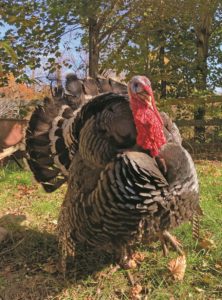Goodness, there are turkeys everywhere! We Outer Cape dwellers watch as ever-growing flocks, or rafters, of these wild birds boldly wander across our lawns and streets. We are also surrounded by an abundance of turkey-inspired decorations, children’s crafts, doormats, napkins, and recipes.
We have one at our homestead. A turkey, that is, and not the one we plan to eat for Thanksgiving dinner. That’s because turkeys make endearing pets. We found this out by chance when we decided to add 10 poults — baby turkeys — to our list of mail-order chicks last March. We were worried about food supplies as Covid-19 began to spread and decided that raising fast-growing turkeys of our own would be one way to avoid possible starvation.
We did not know that domestic turkey poults are a lot less hardy than chicks. Five fluffy-feathered poults perished in our living room. Cue the pandemic-heightened emotions: daughters crying, me walking around the yard swearing at the ugliness of our world.
But that left five surviving “fryers,” as turkeys age four to seven months are ominously called. They quickly won our hearts as they trotted about our yard, chirping, gobbling, and curiously cocking their heads at us when we came near. It turns out that once they have grown past that fragile poult stage, turkeys are a hoot.
At night, they roosted majestically on any high spots they could find: fences, sheds, trees, our truck — basically everywhere, except for the perch we built for them. But they never strayed far. We learned that domestic turkeys are territorial and have little interest in escaping, for they become attached to their humans and adore attention.
So, when it came time to pack our flock into a box and drive the birds to slaughter, it did not come as a shock that one of us cracked. Somebody snuck a tom out of the box and in with our goats. Thus pardoned, “Monsieur Dinde” — M.D., for short — became a pet.

M.D. is as handsome as he is hideous. He boasts a pronounced snood — a blood-filled flap of skin that hangs over a turkey’s beak and indicates the bird’s mood. When M.D. is feeling discontented or disturbed, he retracts his snood so that it becomes a unicorn-like horn in the middle of his forehead; when he is proud and content, it dangles low, changing color to display his thoughts on the possibility of mating.
Monsieur also has a particularly impressive wattle, which is the bumpy, red mass of flesh cascading from his beak down his neck. It is warm and astonishingly pleasant to touch. He craves having his head scratched and his wattle stroked and sidles up when we are close to ask for this treat. He is sociable not only toward us, but has been seen cuddling with our goats and, unfortunately, trying to mate with one of our chickens. This did not end well for the poor hen — now we know, they don’t belong in the same flock.
A word of caution before you decide to order a pet turkey of your own: toms like to gobble loudly. We find that sound delightful, and so do wild turkeys. M.D. attracts large flocks of friends into our yard. When they are there, he struts about like a king. But when they fly up and out of our farm’s enclosure and into the wild, M.D. stays, though he, too, can fly.
That familiar wishbone is the spring that allows this big bird to flap his wings and lift his weight off the ground. When you close your eyes and pull, you might imagine it is the energy of flight that raises the hope your wishes will come true.



